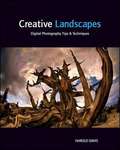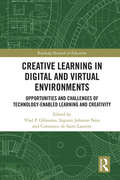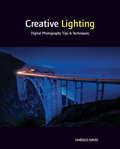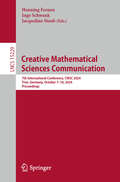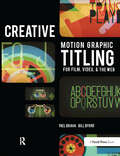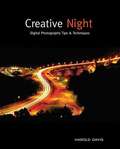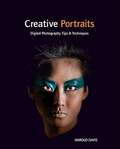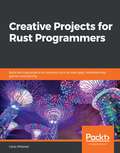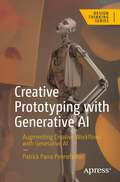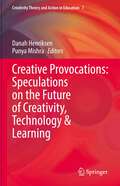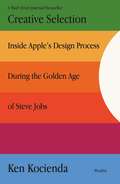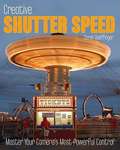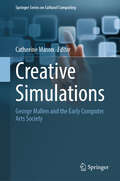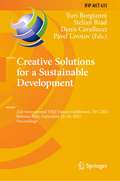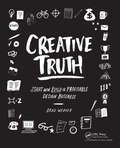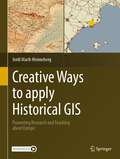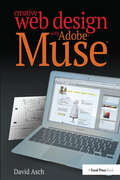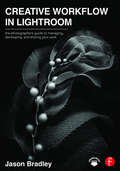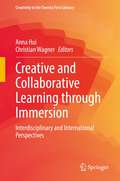- Table View
- List View
Creative Landscapes
by Harold DavisCapture the beauty of the world around you with this professional adviceLandscape photography inspires millions of photographers. If you're one of them, you'll find new insight into landscape photography in this book by professional photographer Harold Davis, as well as tips, tricks, and technical advice to help you improve the quality of your photos. You'll learn to use lighting and composition creatively, choose and use appropriate equipment, look at your subject matter in a new way, and even when to break the rules in order to capture the best image of all. Illustrated with the author's own spectacular landscape photos.Landscape photography intrigues and inspires photographers, but there is more to getting great landscape photos than many photographers expectProfessional photographer Harold Davis teaches tricks and techniques that will enhance your skillsExplains how to approach the subject creatively, choose and use appropriate equipment, and refine photographic technique to create spectacular landscape shotsLooks at how lighting, texture, and composition affect landscape imageryLavishly illustrated with the author's own photosLandscapes have long been a popular photographic subject; this book helps you advance your skills as a landscape photographer.
Creative Learning in Digital and Virtual Environments: Opportunities and Challenges of Technology-Enabled Learning and Creativity (Routledge Research in Education)
by Vlad P. Glăveanu; Ingunn Johanne Ness; Constance de Saint LaurentOriginally published as a special issue of the Creativity Research Journal, this volume gives a balanced and reflective account of the challenges and opportunities of technology-enabled creative learning in contemporary societies. Providing a current and updated account of the challenges posed by the Coronavirus to online education, chapters more broadly offer conceptual reflections and empirically informed insights into the impact of technology on individual and collective creativity and learning. These thoughts are explored in relation to school achievement, the development of digital educational resources, online collaboration, and virtual working. Further, the book also considers how the creative use of technology poses risks to learning through the accidental or deliberate dissemination of misinformation, and online manipulation of common societal values in the era of COVID-19. Creative Learning in Digital and Virtual Environments looks at the connection between creativity, learning, and school achievement, and analyses the impact of virtual environments on creative expression. It will appeal to postgraduate students in the fields of creativity and learning, as well as to students and academics involved with broader research in areas such as the role of technology in education, e-Learning and distance education. Vlad P. Glăveanu is Associate Professor and Head of the Department of Psychology and Counselling at Webster University Geneva, Switzerland, as well as Associate Professor II at the University of Bergen, Norway. Ingunn Johanne Ness is a Senior Researcher at the Centre for the Science of Learning & Technology, University of Bergen, Norway. Constance de Saint Laurent is a Postdoctoral Researcher at the University of Bologna, Italy.
Creative Lighting: Digital Photography Tips and Techniques
by Harold DavisHow to make digital photography lighting more creative--and less challenging!How do you master the art of lighting your photographs? Go beyond the basics, go beyond the "rules," and get creative with the help of renowned photographer Harold Davis. In this book, Harold shows you how to break the boundaries of conventional wisdom and create unique, lively, and beautifully lit photographs. Packed with tips and tricks as well as stunning examples of the author's creativity, this book will both inform and inspire you to create your own lighting style.Teaches you when and how to control the light in your photographsReviews the basic "rules" of digital photography lighting and shows you how to break the rules to create your own uniquely lit imagesHelps you start building a lighting style of your ownIncludes stunning examples of the author's photography and lighting techniquesWhether you're a beginner or a seasoned digital photographer, you'll find ideas and techniques to spark your creativity.
Creative Mathematical Sciences Communication: 7th International Conference, CMSC 2024, Trier, Germany, October 7–10, 2024, Proceedings (Lecture Notes in Computer Science #15229)
by Henning Fernau Inge Schwank Jacqueline StaubThis book constitutes the refereed proceedings of the 7th International Conference on Computer Science and Mathematics , CMSC 2024, held in Trier, Germany, during October 7–10, 2024. The 17 full and short papers included in this book were carefully reviewed and selected from 26 submissions. They were organized in topical sections as follows: Invited Papers; Tactile Learning: Unplugged Graphs, Trees, and Patterns; Teaching Advanced Concepts Using Tangible Machines; Curricular Desicion-Making; Computational Thinking and Interdisciplinary Instruction; Innovative Teaching Beyond the Classroom.
Creative Motion Graphic Titling: Titling with Motion Graphics for Film, Video, and the Web
by Bill Byrne Yael BrahaThe book features genre-based tutorial sections, with step by step instructions for creating effective horror, comedy, drama, and suspense titling sequences. Tutorials for creating some of the most popular title sequences in blockbuster movies are included (Se7en, The Sopranos, 24, The Matrix). Other tutorials teach you how to effectively use sound and VFX in your titles, and also included is instruction on editing your title sequence. These techniques, as well as chapters on the essentials of typography allow you to apply these lessons to your title sequence regardless of whether it's for TV, the web, or digital signage. Also included is a DVD with sample clips, as well as project files that allow you to refine the techniques you learned in the book. As an added bonus we've included 3 titling chapters from other Focal books, with specific instructions on titling within certain software applications. Cover images provided by MK12, from The Alphabet Conspiracy. Learn more at www.MK12.com
Creative Night
by Harold DavisTake a well-timed shot in the dark with this invaluable guide to night photographyShooting in low light and at night is challenging, but it can result in stunning images, so don't put that digital camera away after the sun goes down! Start capturing eerie and intriguing photographs at all levels of light with this information-packed guide from renowned photographer and author Harold Davis.He provides pages of field-tested techniques to help you find the proper exposures, including the best settings for ISO, aperture, and shutter. Don't miss the intriguing examples of his own work, including cityscapes, landscapes, and more.Walks readers through the intricacies of night and low light photography Explores the fundamental rules of exposure, including creative settings for ISO, aperture, and shutter speedsInforms and inspires with the author's own breathtaking examples of night photography, including cityscapes, landscapes, exciting night events, and other photos that illustrate the concepts Capture the visually exciting world after the sun goes down with this essential guide to night photography.
Creative Photography Ideas: 75 Workshops to Enhance Your Photographs
by Tony WorobiecCreative Use of Filters and Further Image Manipulation is an excerpt from Creative Photography Ideas Using Photoshop which presents 75 comprehensive workshops that have been specifically designed for photographers; each offers a clever and creative technique that can be immediately applied.Creative Use of Filters and Further Image Manipulation workshops focus specifically on using a variety of filters to improve or enhance your photographs in Photoshop. From Blur filters to Find Edges filters, and workshops on creating a ghostly effect, retro comic-book effect or pop art look, this eBook will get your creative juices flowing. The section on further image manipulation will guide you through cropping, different ways to remove intrusive elements, and how to construct panoramas.Each workshop offers ingenious creative techniques to immediately enhance images in Adobe Photoshop. From basic techniques to more advanced, all guidance is ‘best practice’ and shown via clear explanatory texts, photographs, ‘before, during and after’ manipulations and screen grabs.
Creative Photography Ideas: Composites and Further Special Effects
by Tony WorobiecComposites and further special effects is an excerpt from Creative Photography Ideas Using Photoshop which presents 75 comprehensive workshops that have been specifically designed for photographers; each offers a clever and creative technique that can be immediately applied.Composites and further special effects workshops focus specifically on creating composites; from dropping in a sky to producing sunbeams, using multiple files, blending mode, refine edge, the gradient tool, multiple layers. There are plenty of creative ideas that will take your photography that little bit further from creating a 'joiner' or 'still movie' to joining two landscapes and creating a mirror image.Each workshop offers ingenious creative techniques to immediately enhance images in Adobe Photoshop.From basic techniques to more advanced, all guidance is ‘best practice’ and shown via clear explanatory texts, photographs, ‘before, during and after’ manipulations and screen grabs.
Creative Photography Ideas: Making Simple Tonal and Colour Changes
by Tony WorobiecIn-computer editing is now as important as in-camera shooting; this book provides ingenious creative techniques to immediately enhance images through this medium.Presents 75 comprehensive workshops that have been specifically designed for photographers; each offers a clever and creative technique that can be immediately applied.Takes a specific, unique slant to provide a wide range of creative tips and tricks designed to appeal primarily to photographers, but also to other ‘creatives’ using the programme.From basic techniques to more advanced, all guidance is ‘best practice’ and shown via clear explanatory texts, photos, ‘before, during and after’ manipulations and screen grabs.
Creative Photography Ideas: Mono Effects and Retro Photography
by Tony WorobiecMono effects and retro photography is an excerpt from Creative Photography Ideas Using Photoshop which presents 75 comprehensive workshops that have been specifically designed for photographers; each offers a clever and creative technique that can be immediately applied.Mono effects and retro photography workshops focus specifically on mono effects such as sepia toning, lith effects, and selective colouring, as well as creating retro photography effects such as pinhole camera, adding borders, and disressing images.Each workshop offers ingenious creative techniques to immediately enhance images in Adobe Photoshop.From basic techniques to more advanced, all guidance is ‘best practice’ and shown via clear explanatory texts, photographs, ‘before, during and after’ manipulations and screen grabs.
Creative Portrait Photography: Innovative Digital Portraiture To Reveal The Inner Subject
by Natalie DybiszThe very best portrait photography strives to give the viewer access into their subject's inner self; to provide a window into their soul. With the advent of the digital age and the potential afforded by post-processing, a whole generation of photographic artists has access to greater creative possibilities than ever before.Spearheading this new breed of creative photographer is author Natalie Dybisz, better known in the photographic community as Miss Aniela. Devoted to exploring portraiture at its most creative portraits with context, story, and constructed elements Creative Portrait Photography takes the reader on a behind-the-scenes journey through the creation of Natalie Dybisz's innovative digital portraits, from first concept to post-processing.Also featuring an extensive showcase chapter in which other photographer-artist's work and working methods are laid bare, Creative Portrait Photography has everything you need to inspire you and transform your perspective on portrait photography.
Creative Portraits
by Harold DavisGo beyond the basic rules of photography to capture stunning portraitsPortrait photography is a vital topic for photographers of every level of experience, from amateur to professional. Written by renowned photographer Harold Davis, this inspirational book encourages you to define our own photographic style and capture stunning, creative, and unique portraits.You'll discover tips and techniques for "breaking the rules" of basic digital photography so that you can go beyond the fundamentals such as composition, lighting, and exposure in order to create memorable and incomparable portraits.Explores the most common subject of most photographers-people-and explains when, why, and how to forgo the fundamentals to capture memorable portraitsEncourages you to define your own unique photographic style and offers information and inspiration to help you do soDelves into a variety of creative techniques that you can use when exploring ways to take lively and stunning portraitsIllustrated with Harold Davis's striking portrait photography, Creative Portraits will both inform and inspire you.
Creative Projects for Rust Programmers: Build exciting projects on domains such as web apps, WebAssembly, games, and parsing
by Carlo MilanesiA practical guide to understanding the latest features of the Rust programming language, useful libraries, and frameworks that will help you design and develop interesting projects Key Features Work through projects that will help you build high-performance applications with Rust Delve into concepts such as error handling, memory management, concurrency, generics, and macros with Rust Improve business productivity by choosing the right libraries and frameworks for your applications Book Description Rust is a community-built language that solves pain points present in many other languages, thus improving performance and safety. In this book, you will explore the latest features of Rust by building robust applications across different domains and platforms. The book gets you up and running with high-quality open source libraries and frameworks available in the Rust ecosystem that can help you to develop efficient applications with Rust. You'll learn how to build projects in domains such as data access, RESTful web services, web applications, 2D games for web and desktop, interpreters and compilers, emulators, and Linux Kernel modules. For each of these application types, you'll use frameworks such as Actix, Tera, Yew, Quicksilver, ggez, and nom. This book will not only help you to build on your knowledge of Rust but also help you to choose an appropriate framework for building your project. By the end of this Rust book, you will have learned how to build fast and safe applications with Rust and have the real-world experience you need to advance in your career. What you will learn Access TOML, JSON, and XML files and SQLite, PostgreSQL, and Redis databases Develop a RESTful web service using JSON payloads Create a web application using HTML templates and JavaScript and a frontend web application or web game using WebAssembly Build desktop 2D games Develop an interpreter and a compiler for a programming language Create a machine language emulator Extend the Linux Kernel with loadable modules Who this book is for This Rust programming book is for developers who want to get hands-on experience with implementing their knowledge of Rust programming, and are looking for expert advice on which libraries and frameworks they can adopt to develop software that typically uses the Rust language.
Creative Prototyping with Generative AI: Augmenting Creative Workflows with Generative AI (Design Thinking)
by Patrick Parra PennefatherReimagine different generative AI as useful creative prototyping tools that can be used to augment your own creative process and projects. Gain a deeper understanding of how generative AI can elevate your creative future. You will acquire a comprehensive understanding of how AI works, uncover tools that can enhance your AI interactions, learn how to extract maximum potential from AI-produced content, and experiment with methods for assessing, refining, and boosting the content to transform your creative projects. You'll also explore how creative professionals from varied disciplines are employing generative AI in their workflows to produce distinctive contributions to the world. Each chapter provides examples of how designers and other creative individuals can utilize these technological wonders, adopting various prototyping techniques to fast-track and optimize design processes and workflows. Creators from all disciplines can tap into the vast capabilities and benefits of generative AI, enabling them to rapidly experiment and prototype their ideas.You Will Learn:Understand how generative AI can support your own creative processLearn tools to get the most out of text-text, text-image, and text-video generative AIAugment your design practices using generative AIDraw inspiration from AI generated content to create unique creative workImprove and streamline creatives processes and workflowsWho This Book Is ForDigital media professionals who want to access off-the shelf creative tools to improve and accelerate their creativity and workflow.Designers and engineers who are looking at novel ways to improve their prototyping and testing processes.Students who want to use AI to rapidly generate ideas to support them in prototyping assignments.Instructors interested in pointing their students to a variety of accessible AI resources to manage their own creativity.
Creative Provocations: Speculations on the Future of Creativity, Technology & Learning (Creativity Theory and Action in Education #7)
by Danah Henriksen Punya MishraThis book explores the complex, yet critical, relationship between technology and creativity, specifically in educational contexts. Creativity is important for success in today’s rapidly changing, radically contingent and hyperconnected world. This is even more relevant in the context of teaching and learning—where the psychological, sociological and cultural aspects of human learning confront the challenges of a rapidly changing, technologically saturated world. Written by some of the foremost thinkers and researchers in the area of creativity and/or technology, the chapters in this volume examine the impact of recent and future technologies on creativity, teaching and learning. Individually and collectively, they help us develop an understanding of this nexus of creativity and technology for education. They offer new perspectives on this rapidly evolving future—exploring issues, paradoxes, tensions, and points of interest for creativity and technology. They position these issues in ways that consider implications for thinking, learning, teaching, and education in general.
Creative Selection: Inside Apple's Design Process During the Golden Age of Steve Jobs
by Ken Kocienda* WALL STREET JOURNAL BESTSELLER *An insider's account of Apple's creative process during the golden years of Steve Jobs.Hundreds of millions of people use Apple products every day; several thousand work on Apple's campus in Cupertino, California; but only a handful sit at the drawing board. Creative Selection recounts the life of one of the few who worked behind the scenes, a highly-respected software engineer who worked in the final years of the Steve Jobs era—the Golden Age of Apple. Ken Kocienda offers an inside look at Apple’s creative process. For fifteen years, he was on the ground floor of the company as a specialist, directly responsible for experimenting with novel user interface concepts and writing powerful, easy-to-use software for products including the iPhone, the iPad, and the Safari web browser. His stories explain the symbiotic relationship between software and product development for those who have never dreamed of programming a computer, and reveal what it was like to work on the cutting edge of technology at one of the world's most admired companies.Kocienda shares moments of struggle and success, crisis and collaboration, illuminating each with lessons learned over his Apple career. He introduces the essential elements of innovation—inspiration, collaboration, craft, diligence, decisiveness, taste, and empathy—and uses these as a lens through which to understand productive work culture.An insider's tale of creativity and innovation at Apple, Creative Selection shows readers how a small group of people developed an evolutionary design model, and how they used this methodology to make groundbreaking and intuitive software which countless millions use every day.
Creative Shutter Speed
by Derek DoeffingerA unique guide to creative shutter speed techniques, illustrated with striking full-color examplesAlong with available light and aperture, shutter speed is one of the variables that determine exposure-the amount of light that reaches the camera's sensor. Set on automatic modes, cameras typically attempt to reduce or eliminate blur in a picture. But by manipulating shutter speed creatively, photographers can achieve a range of striking motion blur or stop-action effects. Using an array of inspiring photographs depicting people, wildlife, and landscapes, Creative Power of Shutter Speed explains how to "read" the light and movement in a potential photograph and identify the best shutter speed for the desired effect.
Creative Simulations: George Mallen and the Early Computer Arts Society (Springer Series on Cultural Computing)
by Catherine MasonThis book is centred on the practitioner-led Computer Arts Society founded in 1969 and formed to address creative computation in all the arts – performance, poetry, text, sound, sculpture and graphics. The objectives and achievements of the Computer Arts Society are presented as realised through their members and exhibitions to the mid-1970s. The Society’s co-founder is Dr George Mallen, a pioneer of cybernetic systems and cultural applications of computing. Creative Simulations contains new research including Mallen’s early work with cybernetician Gordon Pask, whose concepts of interdisciplinarity were influential on the ground-breaking Ecogame (1970). Led by Mallen, Ecogame was a collaborative Computer Arts Society project, an early embodiment of computer technology into art and the first multi-media interactive gaming system in the UK. Pask’s influence in Mallen’s subsequent role at the Royal College of Art where he instigated the first computerlab facilities for artists, is examined. A recently discovered lecture given by Mallen is transcribed, along with reproduction of historic texts by Stephen Willats and John Lansdown (two of his colleagues), which add context to this history of interdisciplinary artistic innovation in the digital realm. Illustrations include art works, ephemera, exhibition posters and installations, preparatory drawings, computing equipment and associated flow charts and diagrams, many appearing here in print for the first time.
Creative Solutions for a Sustainable Development: 21st International TRIZ Future Conference, TFC 2021, Bolzano, Italy, September 22–24, 2021, Proceedings (IFIP Advances in Information and Communication Technology #635)
by Yuri Borgianni Denis Cavallucci Stelian Brad Pavel LivotovThis book constitutes the refereed proceedings of the 21st International TRIZ Future Conference on Automated Invention for Smart Industries, TFC 2021, held virtually in September 2021 and sponsored by IFIP WG 5.4. The 28 full papers and 8 short papers presented were carefully reviewed and selected from 48 submissions. They are organized in the following thematic sections: inventiveness and TRIZ for sustainable development; TRIZ, intellectual property and smart technologies; TRIZ: expansion in breadth and depth; TRIZ, data processing and artificial intelligence; and TRIZ use and divulgation for engineering design and beyond. Chapter ‘Domain Analysis with TRIZ to Define an Effective “Design for Excellence’ is available open access under a Creative Commons Attribution 4.0 International License via link.springer.com.
Creative Truth: Start & Build a Profitable Design Business
by Brad WeaverCreative Truth is your playbook for starting, building, and enjoying a profitable design business. Whether you’re a solo freelancer working from home or a small group of creative entrepreneurs ready to get to the next level, this is your roadmap to success. You’re the CEO, CFO, CTO, Secretary, Janitor, Office Manager, and everything in between. Finding a balance between running the business and doing great creative work is a constant struggle. From learning how to price your work and manage your time, to setting up your business and defining your market, Brad Weaver covers everything designers need to know to run a studio without losing heart. <P><P>Highlights: <li>Real numbers, real tools, and best practices in a toolkit that you can start using immediately in your business. <li>A companion website that offers up-to-date resources, articles, tools, and discussions, allowing readers to continue learning as they grow. <li>Practical tips for getting clients, being more profitable, building your network, managing your operations, getting things done, hiring help, managing contractors, and finding joy along the way.
Creative Ways to apply Historical GIS: Promoting Research and Teaching about Europe
by Jordi Martí-HennebergThis volume promotes the use of Historical GIS (H-GIS) for both education and research. It consists of a coherent set of chapters that allow readers to study the spatial histories of cities, infrastructure, landscapes, and more across Europe. Each chapter is accompanied by Electronic Supplementary Material (ESM) including GIS data, guides and complementary material in .pdf format, and more. To date, there are no similar materials available in this field compiled in a single book. Interdisciplinarity in spatial research is a main theme of this volume, and the text and tools provided here allow readers to combine inputs relating to the study of earth sciences, population, urban growth and transportation, focusing on changes over both space and time. Each chapter provides data in GIS format and also a user's guide to enable readers to deeply engage with the contents themselves. Guidelines are provided to help locate new data about other areas of the world, which users will be able to develop independently. The book is divided into three parts, each presenting different scales of study and analysis at the local, regional and national levels. Part One deals with general subjects analyzed across large areas, mainly within Europe. Part Two provides more specific subjects and data. Part Three covers sources and teaching with H-GIS. The book will be of interest to researchers, academics, teachers and students from secondary schools up to university level. Each subject and tutorial is aimed at a multi-level audience.
Creative Web Design with Adobe Muse
by David AschYou’ve found your Muse; now learn how to create with it Creative Web Design with Adobe Muse is a step-by-step guide to creating fully-featured websites using Adobe Muse. Adobe Muse can be a complicated program, and web design itself is no easy task, although your clients might think so. This book takes you from the initial design and layout stage right up to helping you publish your beautifully designed and richly developed site. Each chapter covers a different section of the website and, in turn, introduces the tools and features of the program, accompanied by useful tips and tricks that help you speed up your workflow. Follow along as a website is created from concept to execution and rich content such as slideshows, galleries, and social media are incorporated. See how each aspect of a website is created with Muse; watch as it’s published; and visit the final version after learning how it was made. If seeing a website created start to finish wasn’t enough, this book also features: Tips on how to incorporate Photoshop into Muse A companion website that was created with Muse where you can get up-to-the-minute coverage on Muse and other tutorials to help you design the perfect website Through this perfect blend of instruction and inspiration, you’ll be up and running with Adobe Muse in no time.
Creative Wedding Album Design with Adobe Photoshop
by Mark ChenPairing photographic creativity with digital-manipulation techniques, this unique manual teaches the use of Photoshop to design artful, distinctive, and compelling wedding albums. Showing that the artistic process need not stop at the click of the shutter, the steps for album creation are detailed reviewing the images, forming a story line, and conveying the tale through well-designed montages. Offering 10 projects with varying levels of complexity and covering diverse skill sets, step-by-step techniques are demonstrated with detailed screen shots--
Creative Workflow in Lightroom: The photographer’s guide to managing, developing, and sharing your work
by Jason BradleyAdobe’s Lightroom has emerged as a must-have software due to its powerful editing tools and time saving organizational capabilities but how you establish a personalized, creative workflow that optimizes this technology, your time, and your art eludes most photographers. Jason Bradley, award-winning photographer and Lightroom pro, shares the answers to these questions in this practical and easy to follow guide that taps into the "how" and the "why" of a professional photographer’s creative workflow in Lightroom. Bradley will show you how all workflows can be simplified into three steps: establishing, managing, and rendering the file, alongside stunning photographs and explanations from his own experiences. This book will not only teach you how to work within Lightroom but, ultimately, how to make Lightroom work for you.
Creative and Collaborative Learning through Immersion: Interdisciplinary and International Perspectives (Creativity in the Twenty First Century)
by Christian Wagner Anna HuiThis book includes instructional design and practice of how immersive technology is integrated in discipline-based and interdisciplinary curriculum design. It focuses on pedagogical models and learning outcomes of immersive learning experiences and demonstrates how immersive learning can be applied in industries. This book brings scholars, researchers and educators together around an international and interdisciplinary consolidation and reflection on learning through immersion. The originality lies in how advanced technology and contemporary pedagogical models can integrate to enhance student engagement and learning effectiveness in higher education.
